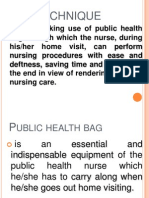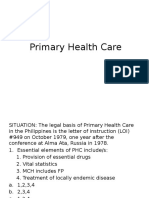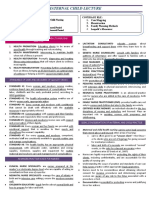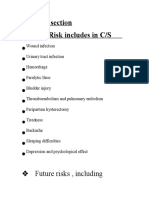Introduction To Midwifery
Introduction To Midwifery
Uploaded by
Tiara AmanahCopyright:
Available Formats
Introduction To Midwifery
Introduction To Midwifery
Uploaded by
Tiara AmanahOriginal Title
Copyright
Available Formats
Share this document
Did you find this document useful?
Is this content inappropriate?
Copyright:
Available Formats
Introduction To Midwifery
Introduction To Midwifery
Uploaded by
Tiara AmanahCopyright:
Available Formats
INTRODUCTION TO MIDWIFERY
The simplest definition of midwifery is “with woman”, but truly, midwifery
means different things to different people. For many, the midwifery model is
an attitude about woman and how pregnancy and birth occur, and view that
pregnancy and birth are normal events until proven otherwise. It is an
attitude of giving and sharing information, of empowerment, and of
respecting the right of a woman and her family to determine their own care.
1. Definisi dari kebidanan
Definition of midwifery
2. Perbedaan pelayanan bidan dengan rumah sakit
The differences between midwifery care with hospital
3. Tugas seorang bidan
The duty (obligation) of midwife
The attitude of midwifery, or the midwifery model can be contrasted with
the medical model. In general, Medical Model is an attitude that there is
potential pathology in any given situation, and that medicine can assist to
improve the situation. Medicine is also about teaching, informing, and
prevention, but the power seems to be more with the provider rather than
with the woman.
1. Perbedaan keputusan medis dengan keputusan bidan
The contrasted between medical and midwife decision
2. Model kebidanan dan model medis
Midwifery model and medical model
3. Semua perempuan bisa melahirkan secara normal
All women can deliver (have a birth) normally
All women can have a normal birth
Historically, midwifes have always been around to help woman give birth.
Before physicians, midwifes were the primary healers in their communities.
They were the medicine women of their own cultures, and assisted families
and woman throughout their lives. In the old testament they were described
as examples of the strength and faith in God.
Midwifes were once the nutritionists, herbalists, doctors, ministers,
counselors, all rolled in to one ‘profession. Many feel they were the first
holistic practitioners. Midwifes were always available to help the poor, the
woman without medical care or the woman who were the outcasts of their
culture. Today, midwives take care of anyone who wishes to see them, but
practice within the constraints of their medical and legal systems.
Today midwives are as diverse as the populations they serve. Midwives are
willing to take care of anyone who wishes to see them. Over 70% of birth in
the world are attended by midwives. In the Netherlands, midwives deliver a
majority of the babies. Other countries do not utilize
midwives to their fullest potential. Each country worldwide has a slightly
different view of midwifery, and of how midwives work within their
communities. In sci.med.midwifery, midwives will speak from these various
perspectives and cultures. Midwives are encouraged to share their
statistics and work situations within this newsgroup.
The World Health Organization (WHO) presents us with the following
definition of the midwife:
A midwife is a person who having been regularly admitted to a midwifery
educational program, duly recognized in the country in which it is located,
has successfully completed the pescribed course of studies in midwifery
and has acquired the requisite qualifications to be registered and/or legally
licensed to practice midwifery.
(WHO, FIGO, ICM statement)
Midwives teach, educate and empower woman to take control of their own
health care. In most communities, they provide prenatal care, or
supervision of the pregnancy, and then assist the mother to give birth. They
manage the birth, and guard the woman and her newborn in the
postpartum period.
Most midwives encourage and monitor women throughout their labor with
techniques to improve the labor and birth. Reassurance, positive imaging
and suggestions to change position and walk helps labors progress. Many
midwives provide family planning services and routine women’s health
examinations such as pap smears and physical examinations.
They teach women about sexually transmitted infections, and focus on
prevention of the spread of infections. What specifically midwifes do will
depend on: her training, her licensure, and what is allowed in the state,
province, or country in which she practices.
For example, in the united states some midwives can prescribe
medications, provide women’s health care throughout the menopause
years. Midwives worldwide births in the home, hospital or birthing center,
depending upon their education and licensure, and the rules governing
their practices.
Midwives believe it is especially important to provide time for questions,
teaching, and time to listen to the concerns and needs of the women they
care for. The WHO definition of the midwife gives us the following
guidelines about what midwives do:
She must be able to give the necessary supervision, care, and advice to
women during pregnancy, labour and the postpartum period, to conduct
deliveries on her own responsibility and to care for the newborn and the
infant. This care includes preventative measures, the detection of abnormal
conditions in mother and child, the procurement of medical assistance and
the execution of emergency measures in the absence of medical help. She
has an important task in health counseling and education, not only for the
woman, but also within the family and the community. The work should
involve antenatal education and preparation for parenthood and extends to
certain areas of gynecology, family planning and child care. She may
practice in the hospitals, clinics, health units, domiciliary conditions of in
any other services. (WHO,FIGO, ICM Statement).
Answer the questions!
1. What is midwife?
2. What do midwives do?
3. What is midwifery according to the text?
4. What is midwife according to your opinion?
The questions for discussion.
1. What is difference between midwife and obstetrician, explain briefly!
2. Why do you want to be midwife?
3. Is midwifery care safe?
You might also like
- Facilitation Summary For Judge's Bench Brief On Liability - With ExhibitsDocument123 pagesFacilitation Summary For Judge's Bench Brief On Liability - With Exhibitsbrandon carr100% (1)
- HEALTH ASSESSMENT Syllabus 2023 2Document16 pagesHEALTH ASSESSMENT Syllabus 2023 2Raibert Rosales100% (1)
- MID 100 SyllabusDocument2 pagesMID 100 SyllabusAbby Umali-Hernandez100% (2)
- Basic Competencies of MidwiferyDocument10 pagesBasic Competencies of Midwiferyannu panchal100% (1)
- Mother and Baby Friendly Hospital Initiative - Session 15 MBFHDocument27 pagesMother and Baby Friendly Hospital Initiative - Session 15 MBFHthirdielacorte67% (3)
- Introduction To MidwiferyDocument4 pagesIntroduction To MidwiferyAuliya Risha100% (1)
- ncm-104: Community Health Nursing I: Jennifer J. Valero, Man-Rn Clinical InstructorDocument48 pagesncm-104: Community Health Nursing I: Jennifer J. Valero, Man-Rn Clinical InstructorCorpus, Irene Zen P.100% (3)
- Pathological Obstetrics, Basic Family Planning and Care of InfantsDocument96 pagesPathological Obstetrics, Basic Family Planning and Care of InfantsScarlet AmodiaNo ratings yet
- Community DiagnosisDocument21 pagesCommunity DiagnosisAbhugz MarceloNo ratings yet
- Code of Ethics For MidwivesDocument2 pagesCode of Ethics For MidwivesiamgiegaNo ratings yet
- Midwifery Skills Clinical Laboratory: The Midwives ProcessDocument26 pagesMidwifery Skills Clinical Laboratory: The Midwives ProcessNano KaNo ratings yet
- Functions of Midwife - 133302357Document7 pagesFunctions of Midwife - 133302357Rijane Tabonoc Omlang100% (2)
- Quality Issu in Midwifery ICM PDFDocument9 pagesQuality Issu in Midwifery ICM PDFFarhatiNo ratings yet
- Assessing Breasts and AxillaeDocument23 pagesAssessing Breasts and AxillaeKamile Abrahan GarciaNo ratings yet
- ICM Essential Competencies For Basic Midwifery Practice 2010, Revised 2013 PDFDocument19 pagesICM Essential Competencies For Basic Midwifery Practice 2010, Revised 2013 PDFKuurniiaa PraweestiiNo ratings yet
- Ethics in Midwifery PracticeDocument42 pagesEthics in Midwifery PracticeDivya Grace95% (19)
- FAMILY PLANNING MCN 101Document31 pagesFAMILY PLANNING MCN 101kaycelyn jimenezNo ratings yet
- First Progress Report of Midwifery Project IDSP PakistanDocument39 pagesFirst Progress Report of Midwifery Project IDSP PakistanmimranfaizNo ratings yet
- Care of Mother and The Fetus During The Perinatal PeriodDocument30 pagesCare of Mother and The Fetus During The Perinatal PeriodPinsoy, Bruce riano e.No ratings yet
- Bag TechniqueDocument40 pagesBag TechniquemesdejenNo ratings yet
- Family Health Nursing 3Document60 pagesFamily Health Nursing 3mark Orpilla0% (1)
- Historical Development of Midwifery: Cedrick James A. Sabulao DM 40Document13 pagesHistorical Development of Midwifery: Cedrick James A. Sabulao DM 40Marwin Odita100% (1)
- Postnatal Care at The Health Post and in The CommunityDocument23 pagesPostnatal Care at The Health Post and in The CommunityGreggy Francisco LaraNo ratings yet
- Respectful Maternity CareDocument33 pagesRespectful Maternity CareJenelle Melinda TullochNo ratings yet
- The Family Health Process PDFDocument95 pagesThe Family Health Process PDFMICHELLE MONTEBONNo ratings yet
- Midwifery Terminology: Mrs.V.Elizebeth Rani ReaderDocument14 pagesMidwifery Terminology: Mrs.V.Elizebeth Rani ReaderSamira MohamudNo ratings yet
- Introduction To Midwifery ObstetricDocument1 pageIntroduction To Midwifery Obstetricnursing schoolNo ratings yet
- Anthropometric MeasurementsDocument18 pagesAnthropometric MeasurementsJaezee Ramos50% (2)
- Primary Health CareDocument15 pagesPrimary Health Carekinid100% (1)
- RN BSN-CIG-Topic 14 - Concepts of Primary Health CareDocument34 pagesRN BSN-CIG-Topic 14 - Concepts of Primary Health CarebettinabetsonNo ratings yet
- Mercer TheoryDocument3 pagesMercer TheoryDiane-Richie PezLo50% (2)
- Ethics in Midwifery PDFDocument2 pagesEthics in Midwifery PDFStevenNo ratings yet
- Oral and Parenteral Iron Preparations in PregnancyDocument45 pagesOral and Parenteral Iron Preparations in PregnancyArun George100% (3)
- Family Health AssessmentDocument47 pagesFamily Health Assessmentangeleigh viernesNo ratings yet
- Scope of Midwifery Practice Concept Analysis PDFDocument6 pagesScope of Midwifery Practice Concept Analysis PDFKunal MahajanNo ratings yet
- Immunization: Expanded Program On Immunization (EPI)Document4 pagesImmunization: Expanded Program On Immunization (EPI)3amabelle arevaloNo ratings yet
- New Midwifery RequirementsDocument4 pagesNew Midwifery RequirementsLei DecenaNo ratings yet
- MidwiferyDocument11 pagesMidwiferySiti alviraaNo ratings yet
- Primary Health CareDocument133 pagesPrimary Health CareSteveNo ratings yet
- Introduction To MidwiferyDocument27 pagesIntroduction To MidwiferySHOWMAN DEEPAK100% (2)
- San Pedro - Training and Monitoring of Midwives For Their Expanded Role in Maternal and Child HealthDocument18 pagesSan Pedro - Training and Monitoring of Midwives For Their Expanded Role in Maternal and Child HealthHendrix Antonni Amante67% (3)
- Community Nursing Diagnosis PDFDocument38 pagesCommunity Nursing Diagnosis PDFRemy Diocena TanaNo ratings yet
- Presentation On Nurse Specialists RolesDocument28 pagesPresentation On Nurse Specialists RolesRaphael KorkortsiNo ratings yet
- Maternal Child Lecture: Standards of Maternal and Child Health Nursing PracticeDocument29 pagesMaternal Child Lecture: Standards of Maternal and Child Health Nursing PracticeZoè AshtrönNo ratings yet
- CHN 1 Topic 1. A Handout in Overview of Public Health Nursing in The Phils.Document11 pagesCHN 1 Topic 1. A Handout in Overview of Public Health Nursing in The Phils.DANIAH ASARI. SAWADJAANNo ratings yet
- Practicum OrientationDocument26 pagesPracticum OrientationJomer Gonzales100% (1)
- CHN Prelim QuizDocument5 pagesCHN Prelim QuizVanessa Mae Rara100% (1)
- Learning Guide PHC 2Document20 pagesLearning Guide PHC 2Niña Amato100% (1)
- 5 Suceessful Entrepreneur in MidwiferyDocument15 pages5 Suceessful Entrepreneur in MidwiferyKervin Lance Pascua0% (1)
- Community Health Nurse RolesDocument4 pagesCommunity Health Nurse Rolescoy008No ratings yet
- Maternal and Fetal Assessment During LaborDocument66 pagesMaternal and Fetal Assessment During LaborHazelynne Mamucud100% (2)
- BemoncDocument84 pagesBemoncJUANJOSEFOX100% (1)
- Family Coping Index 1Document28 pagesFamily Coping Index 1The Blue and Gold RvdNo ratings yet
- CMO No.33 s2007Document92 pagesCMO No.33 s2007queenfaustineeNo ratings yet
- Jason OrnopiaDocument3 pagesJason OrnopiaVirginia BarnesNo ratings yet
- Republic Act No. 7392 An Act Revising Republic Act No. 2644, As Amended, Otherwise Known As The Philippine Midwifery ActDocument6 pagesRepublic Act No. 7392 An Act Revising Republic Act No. 2644, As Amended, Otherwise Known As The Philippine Midwifery ActRam AugustNo ratings yet
- Abstract For ADVANCE Nurse PracticeDocument3 pagesAbstract For ADVANCE Nurse PracticeDr-Marudhar MarudharNo ratings yet
- Board of Midwifery-CEDocument4 pagesBoard of Midwifery-CEinvictus0446100% (4)
- Introduction To Maternal NursingDocument128 pagesIntroduction To Maternal NursingNathalina DeepikaNo ratings yet
- Maternal and Child Health Nursing: May Ann B. Allera, RNDocument16 pagesMaternal and Child Health Nursing: May Ann B. Allera, RNmayal100% (1)
- MCNHNDocument64 pagesMCNHNKate100% (1)
- Aromaterapi Terhadap Pengurangan Mual Muntah Pada Ibu HamilDocument11 pagesAromaterapi Terhadap Pengurangan Mual Muntah Pada Ibu HamilYosi FebriNo ratings yet
- Breast Problems Faced by Lactating MothersDocument26 pagesBreast Problems Faced by Lactating MothersjisooNo ratings yet
- International Fetal Size Standards in Early Pregnancy: Centiles Gestational Age (Weeks + Days)Document4 pagesInternational Fetal Size Standards in Early Pregnancy: Centiles Gestational Age (Weeks + Days)Shoaib AlamNo ratings yet
- Postpartum Hemorrhage: Prepared By: Bande, Kyla Marie O. Lorente, Alfie John CDocument22 pagesPostpartum Hemorrhage: Prepared By: Bande, Kyla Marie O. Lorente, Alfie John CNi Ki TaNo ratings yet
- Example QuizDocument17 pagesExample QuizDianne LabisNo ratings yet
- Breastfeeding Posters and DisplaysDocument3 pagesBreastfeeding Posters and DisplaysDhea Rizky Amelia SatoNo ratings yet
- Routine Postnatal Care 4.0Document25 pagesRoutine Postnatal Care 4.0Razelle Hilary Viaña CastroNo ratings yet
- Done Uterine RuptureDocument3 pagesDone Uterine RupturejnapalaNo ratings yet
- Multiple PregnancyDocument20 pagesMultiple PregnancyNurul Fahmiza TumiranNo ratings yet
- RH IncompatibilityDocument3 pagesRH IncompatibilityMima Fatimah LuthfieNo ratings yet
- DAY 1 COMMUNITY DUTY - BSN 2 - 7aDocument2 pagesDAY 1 COMMUNITY DUTY - BSN 2 - 7akaycelyn jimenezNo ratings yet
- Tables For Master List 1Document7 pagesTables For Master List 1RickNo ratings yet
- AMTSL BrieferDocument2 pagesAMTSL BrieferNewborn2013No ratings yet
- Ward TeachingDocument23 pagesWard Teachingvani reddyNo ratings yet
- SC Oligo + IUGRDocument21 pagesSC Oligo + IUGRIrwin FitriansyahNo ratings yet
- How To Raise An Amazing ChildDocument197 pagesHow To Raise An Amazing ChildMersi Ta100% (8)
- IPPF QI ProjectDocument11 pagesIPPF QI Projectsisay tolosaNo ratings yet
- INTRODUCTION Teenage Pregnancy - Docx MilynDocument2 pagesINTRODUCTION Teenage Pregnancy - Docx Milynprince4hircs4christi100% (7)
- Unit-2 Antenatal AssessmentDocument16 pagesUnit-2 Antenatal AssessmentAnil Patel100% (5)
- BibliographyDocument17 pagesBibliographyChristian D BlessingNo ratings yet
- Case-Map-Beto-Beto-Family-De Jesus-Lovelle-GraceDocument11 pagesCase-Map-Beto-Beto-Family-De Jesus-Lovelle-GraceLOVELLE GRACE DE JESUSNo ratings yet
- Shoulder Dystocia NCPDocument6 pagesShoulder Dystocia NCPNicole Genevie MallariNo ratings yet
- Determining-Gravidity-And-Parity and How To Solve For AOG and EDDDocument15 pagesDetermining-Gravidity-And-Parity and How To Solve For AOG and EDDJoseph Hechanova AsenjoNo ratings yet
- Maternal and Child Health Nursing Ii: Krishan Soriano, MSNDocument130 pagesMaternal and Child Health Nursing Ii: Krishan Soriano, MSNjay5ar5jamorabon5torNo ratings yet
- Rajiv Gandhi University of Health Sciences Bangalore, KarnatakaDocument14 pagesRajiv Gandhi University of Health Sciences Bangalore, KarnatakaVeni SafitriNo ratings yet
- Caesarean SectionDocument16 pagesCaesarean SectionA B Siddique RiponNo ratings yet
- Kelompok 7 - Tugas Kelompok English - Kelas 1b Alih JenjangDocument3 pagesKelompok 7 - Tugas Kelompok English - Kelas 1b Alih JenjangSusanti RosdianiNo ratings yet
- AnnouncementDocument42 pagesAnnouncementzaki hetamiNo ratings yet

























































































